 Settings for developers significantly expand the functionality of your phone, and you do not need to install third-party firmware or get root-rights in the system.
Settings for developers significantly expand the functionality of your phone, and you do not need to install third-party firmware or get root-rights in the system.
Also, the developer mode allows you to perform performance tests on the phone, record the operation log of various applications + system errors, configure wireless connections, set up sound, animation and smartphone performance.
How do I enable developer settings?
Go to Settings> About phone> Version MIUI.
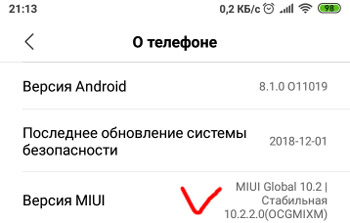
Press 5-7 times by version MIUI. A pop-up will appear informing you that you have enabled developer mode (you are a developer). Done, a new menu item has appeared.
Go to developer mode: Settings> Advanced settings> For developers.

to the content
Developer settings
Activate developer mode for the following features to become available:
- Password for backups. When you back up your data, it is not secure by default, anyone can access your data. But you can set a password for the archive with files.
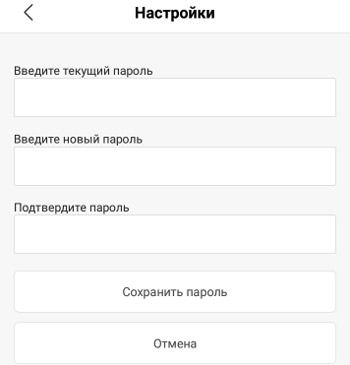
- Do not turn off screen – the phone screen will always be on while charging.
- Skip lock screen – go straight to the desktop when you wake up. Do not enable this feature to protect your phone and personal data from third parties.
- Log Bluetooth HCI – All transmitted data packets are written to the log.
- Trace log Bluetooth – on / off. Tracing allows you to see the work of the program step by step – action by action. This is necessary to find weaknesses and either protect the application or hack it.
- OEM Unlock – Allows unlocking the OS bootloader. This is needed to get root rights on the phone and install custom firmware.
- Running Applications – View and manage running applications. Just select the application and forcefully stop it.
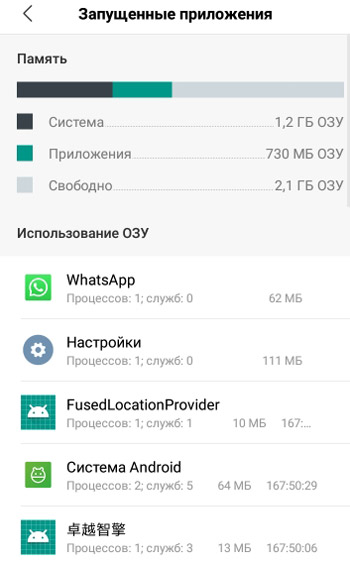
- Service WebView – allows you to open links to sites on the Internet inside a running application. I have Chrome browser on my phone.
- Demo mode – the clock in the status bar will stop and the battery and network alarm icons will be shown full. To undo the changes, turn off demo mode or restart your phone.

- Fragments of quick settings: Show boundaries of objects;
- profile GPU rendering – improves the image on the screen, but slows down the overall performance of the device;
- mirror interface. Position of icons and settings as in mirror image;
- animation of windows – enable animation.

- Mi Unlock status – check bootloader lock. Usually the bootloader is unlocked so that the phone can be flashed.
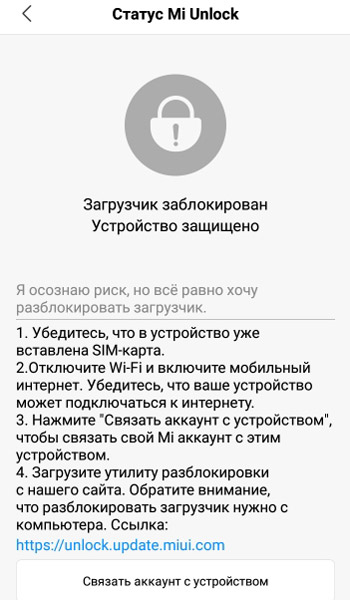
To unlock the bootloader, do the following:
- The SIM card must be inserted into the phone.
- Disable Wi-Fi and enable mobile internet (data transfer). Make sure the internet is working.
- Click on the “Link account with device” button (see screenshot above) to link your Mi account with this phone.
- Download the unlock utility from unlock.update.miui.com. To unlock, connect the phone to the computer via a cable, follow the instructions of the program.
to the content
Developer Mode: Debug Settings
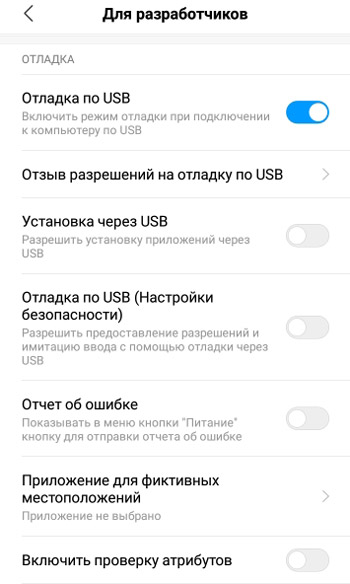
- USB Debugging – enables debugging mode when you connect your phone to a computer via a cable.
- Revoke USB Debugging Permissions – Deny access to usb debugging for all computers that have it.
- Install via USB – allow installing applications to the phone from a computer via a cable.
- USB Debugging (Security Settings) – Allow granting of permissions and simulate input using usb debugging. This could lead to personal data leakage. I do not recommend using this option unless you are a developer.
- Error report – show the button for sending an error report to the manufacturer's servers in the “Power” button menu.
- An app for mock locations. Choose an application that will record false information about your travel history.
- Enable attribute validation.
- Debugging app is an option for developers. Select an installed application for debugging and testing.
- Waiting for debugger – the application being debugged will wait for the debugger to connect.
- Check applications upon installation – all applications on the phone that you install will be scanned for viruses and security.
- Log buffer – log size in kilobytes, text document.

- Log level – what types of errors and warnings will be written to the log:
- off – there will be no recording;
- Error – serious errors;
- Warn – warnings;
- Info – informational messages;
- Debug – messages of the debugger program when testing the code;
- Verbose – a detailed program report on all performed actions and their results, including execution errors.

- Enable atrace – recording system kernel events using atrace.
to the content
Developer Mode: Network Settings
- Wireless Display Certification – Shows the wireless display certification options.
- Detailed Wi-Fi log – when choosing a wi-fi network, indicate in the log the RSSI (Received Signal Strength Indicator) for each SSID. Those. show the quality of the wifi signal.
- Aggressive network switching – forcibly switch to the mobile Internet when the wi-fi signal is weak. This may result in overuse of mobile Internet traffic packets – I do not advise turning it on.
- Always enable search for Wi-Fi networks – enable or disable search for Wi-Fi networks during data transfer, depending on the amount of traffic.
- Do not disable mobile Internet – do not disable data transmission over the cellular network, even with an active wi-fi connection (to quickly switch between networks).
- USB configuration – which operating mode to choose when connecting the phone via cable to a computer:
- charging only;
- MTP – transfer of media files;
- PTP – transfer of photos;
- RNDIS – a phone as a usb modem;
- sound source;
- MIDI – Data exchange with musical instruments (when connecting a smartphone to a musical set).
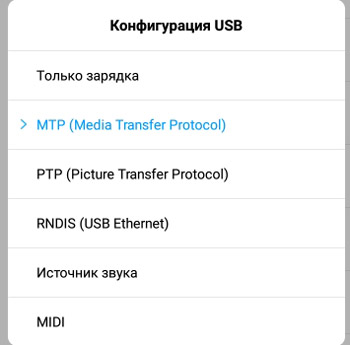
- Disable the absolute bluetooth volume level when problems arise on remote devices, for example, when the sound is too loud or the setting cannot be controlled.
- Version Bluetooth AVRCP – bluetooth version for audio signal transmission (1.4, 1.5, 1.6).
- Audio codec for transmission via bluetooth – which codec to choose for audio signal compression.
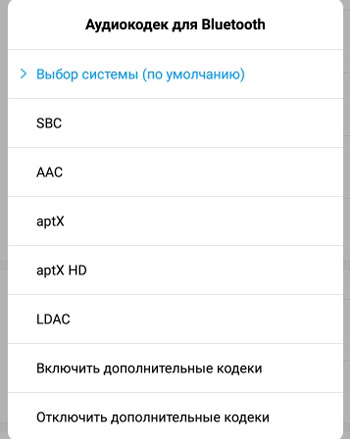
- Sampling rate when transmitting through Bluetooth – used to digitize the signal. 44.1 kHz is quite enough for a quality signal.
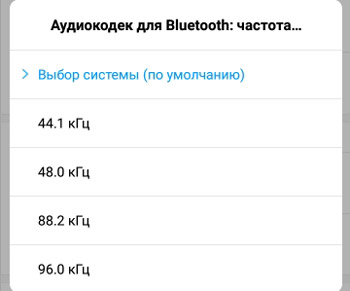
- Audio coding depth when transmitting through Bluetooth – 16 bits / sample is enough.

- Audio channel mode Bluetooth – mono or stereo sound.
- LDAC audio codec for Bluetooth: bitrate quality. What balance should be observed when transmitting a sound signal (music, conversation) via bluetooth:
- emphasis on quality (bit rate) and low bit rate,
- balanced transmission – balance of sound quality and speed,
- emphasis on signal transmission rate with degraded quality,
- adaptive bitrate – the system itself adjusts the signal based on the quality of the current bluetooth signal.
to the content
Developer Mode: Input Settings
- Show touches – visualize any touches and gestures on the phone screen. A circle will appear on the screen to follow your movements.
- Pointer location – the pointer movement + its coordinates is being recorded on the screen.

to the content
Developer mode: rendering
- Highlight windows – fully highlight windows when they are updated. Those. any change in the open window of any application will flicker bright purple backlight
- Show boundaries of objects – i.e. show crop borders, margins, etc.

- Flip UI – enable right-to-left spelling for all languages.
- Animating Windows – select the animation speed (from 1x to 10x).
- Transition animation – select the animation speed when changing the application window (from 1x to 10x).
- Animation duration is from 1x to 10x.

- Emulation of secondary screens – shows a second screen on the main screen, you can customize the size of the secondary screens.
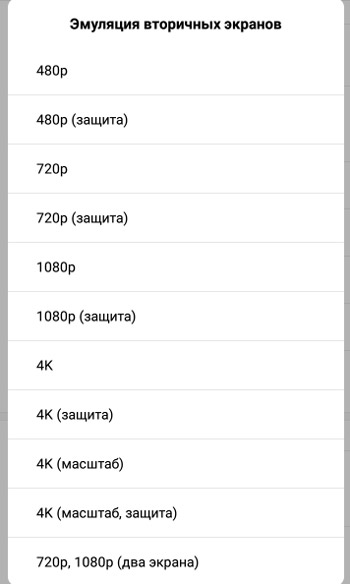
- Secondary screen minimum width – set the width in points.
to the content
Developer Mode: Hardware Accelerated Rendering
- Enable GPU Acceleration – Use the power of your phone's graphics accelerator to render 2D graphics. The picture quality will improve, but the performance may decrease.
- Show hardware updates – Highlight areas of the screen in red when rendering from the GPU.
- Show Hardware Layers Refresh – Highlight hardware layers green when refreshed.
- Debug GPU Overlay: Show areas of overlap or areas for deuteranomaly.
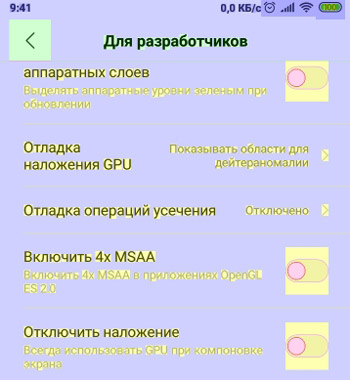
- Debug clipping operations: Draw the clipping region in blue, or highlight drawing commands in green.

- Enable 4x MSAA – Enables the option in OpenGL ES 2.0 applications. This is an anti-aliasing operation to eliminate the “jaggedness” effect when many images are displayed on the screen that are superimposed on each other. This will improve the picture quality, but there will be a strong battery discharge.
- Disable Overlay – Always use GPU when composing screen
- Simulate anomaly – simulates the image as seen by people with visual impairments. Imitation available: monochromatic (black and white), deuteranomaly (red-green), protanomaly (red-green), tritanomaly (blue-yellow).
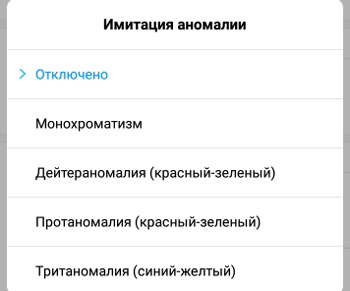
- Renderer: OpenGL or OpenGl. The option is responsible for the picture, graphics on the phone screen.
to the content
Developer Mode: Multimedia
There is only one option: Disable usb audio transmission. By activating this function, you will prevent the transmission of sound to external USB devices connected to the phone.

to the content
Developer Mode: Monitoring
- Strict mode – flashing the screen during long operations on the main thread.
- Profile GPU rendering: on the screen as stripes or in adb shell dumpsys gfxinfo.
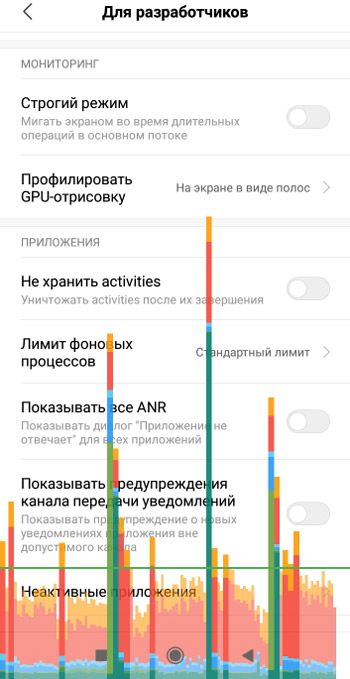
to the content
Developer Mode: Apps
- Don't store activities – i.e. forcibly destroy (stop, close) parts of applications with which the user interacts. For example, you write an SMS – this is the activity of the “Messages” application; or take a photo – this is an activity of the “Camera” application. Those. part of the application is closed (it is not deleted!) so that it does not hang in the RAM, which speeds up the performance of the smartphone.
- Background process limit – how many applications and processes can run in the background. The smaller, the faster the phone works.

- Show all ANRs – show the “Application not responding” dialog for all applications – this is in case the program hangs.
- Show notification channel warnings – Show a warning about new app notifications outside of a valid channel. I do not recommend using this option.
- Inactive applications – select an active application from the list to forcibly disable it, the application will not be removed from the phone.
- Show application errors – show information about critical errors in the operation of programs. If you are not a developer or a tester, such messages will not help you.
- Allow saving to external drives – allow applications in the phone to save their data, cache and saves to an external drive, regardless of what is specified in the settings. An external storage device can be a computer, an external hard drive, a USB flash drive connected via an OTG cable to the phone, or a memory card.
- Allow resizing – allow resizing of windows in multi-window mode regardless of what is specified in the settings.
- Reset the ShortcutManager counters. The option resets all application shortcuts on the home screen and in the phone menu.
- Enable optimization MIUI – optimize the graphical and system shell of your smartphone for performance.
- Notify about dangerous functions. If you activate any option that affects the security of your phone and personal data, a warning will appear on the screen.
Let's summarize. We've covered all features and services in developer mode. Most of them are simply not needed by an ordinary user, they are intended for testers and OS developers, additional software and applications. but there are also a number of useful individual features, such as GPU acceleration or aggressive network switching (use mobile data and wi-fi at the same time).
You configure all options at your own peril and risk. Therefore, if you are not sure, it is better not to turn it on.
